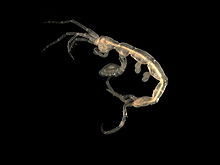Skeleton shrimp
| Skeleton shrimps Caprellidae |
|
|---|---|
 |
|
| Pariambus typicus | |
| Scientific classification | |
| Kingdom: | Animalia |
| Phylum: | Arthropoda |
| Subphylum: | Crustacea |
| Class: | Malacostraca |
| Order: | Amphipoda |
| Suborder: | Corophiidea |
| Infraorder: | Caprellida |
| Family: |
Caprellidae Leach, 1814 |
| Synonyms | |
|
|
Caprellidae is a family of amphipods commonly known as skeleton shrimps. Their common name denotes the threadlike slender body which allows them to virtually disappear among the fine filaments of seaweed, hydroids and bryozoans. They are sometimes also known as ghost shrimps. Caprellidae contains 88 genera in three subfamilies.
Caprellids are easily recognizable from other amphipods because of their slender elongated bodies. Their bodies can be divided into three parts - the cephalon (head), the pereon (thorax), and the abdomen. The pereon comprises most of the length of the body. It is divided into seven segments known as pereonites. The cephalon is usually fused to the first pereonite; while the highly reduced and almost invisible abdomen is attached to the posterior of the seventh pereonite. They possess two pairs of antennae, with the first pair usually longer than the second pair. The cephalon contains mandibles, maxillae, and maxillipeds which function as mouthparts.
Each pereonite has a pair of appendages known as pereopods. The first two pairs are modified into raptorial appendages known as gnathopods. These are used for feeding and defense, as well as locomotion. The third and fourth pair of pereopods are usually reduced or absent altogether. In the third and fourth pereonites are two pairs of gills. Sometimes a third pair of gills may also be present on the second pereonite. In mature females, brood pouches formed by extensions of the coxae (oostegites) are present on the third and fourth pereonites. The fifth to seventh pair of pereopods are smaller than the gnathopods and are used for clasping objects the animals anchor themselves upon.
Most caprellids are highly sexually dimorphic, with the males usually being far larger than the females.
...
Wikipedia
